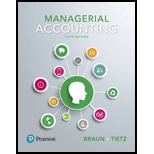
Concept explainers
Comprehensive summary problem (Learning Objectives 2 8 3)
Birdhouses Inc. makes backyard birdhouses. The company sells the birdhouses to home improvement stores for $20 per birdfeeder. Each birdhouse requires 2.0 board feet of wood, which the company obtains at a cost of $5 per board foot. The company would like to maintain an ending stock of wood equal to 15% of the next month’s production requirements. The company would also like to maintain an ending stock of finished birdfeeders equal to 10% of the next month’s sales.
Sales data for the company is as follows:
| Units | |
| October actual sales (prior year) | 72.000 |
| November actual sales (prior year) | 84.000 |
| December actual sales (prior year) | 91,000 |
| January projected sales | 95.000 |
| February projected sales | 105,000 |
| March projected sales | 110,000 |
| April projected sales | 125,000 |
In any given month, 25% of the total sales are cash sales, while the remainder are credit sales.
The company’s collection history indicates that 75% of credit sales is collected in the month after the sale, 15% is collected two months after the sale, 8% is collected three months after the sale, and the remaining 2% is never collected. Assume that the total cost of direct materials purchases in December was $1,001,000. The company pays 60% of its direct materials purchases in the month of purchase and pays the remaining 40% in the month after purchase.
Requirements
- 1. Prepare the following budgets for the first three months of the year, as well as a summary budget for the quarter.
- 2. Prepare the sales budget, including a separate section that details the type of sales made (cash versus credit).
- 3. Prepare the production budget.
- 4. Prepare the direct materials purchases budget. Assume the company needs 242,000 board feet of wood for production in April.
- 5. Prepare the cash collections budget for January, February, and March, as well as a summary for the first quarter.
- 6. Prepare the
cash payments budget for direct materials purchases for the months of January, February, and March, as well as a summary for the first quarter.
Want to see the full answer?
Check out a sample textbook solution
Chapter 9 Solutions
Managerial Accounting (5th Edition)
- On January 1, Lightbulbs, Inc. issued 5-year bonds with a $400,000 face value. The bonds have a contract rate of 6% and were issued at 96. What is the bond interest expense on the first semi-annual interest payment date using straight-line amortization?arrow_forwardWhat will be the company's contribution margin?arrow_forwardNeed help with this accounting questionsarrow_forward
- Hi teacher please help me this question general accountingarrow_forwardDoes the pattern of variances suggest Pro Fender's managers have been making trade-offs?arrow_forwardGreen Co. incurs a cost of $15 per pound to produce Product X, which it sells for $26 per pound. The company can further process Product X to produce Product Y. Product Y would sell for $30 per pound and would require an additional cost of $10 per pound to be produced. The differential cost of producing Product Y is: a. $15 per pound b. $26 per pound c. $30 per pound d. $10 per poundarrow_forward
- Financial Accountingarrow_forwardWhen a company pays cash for a truck, what is the effect on the accounting equation for that company? A. Increase assets and increase liabilities. B. Decrease assets and decrease liabilities. C. Increase assets and increase equity. D. No net change.arrow_forwardNO WRONG ANSWERarrow_forward
- Baltimore Company experienced an increase in total assets of $12,500 during the current year. During the same time period, total liabilities increased $9,100. Shareholders made no investments during the and no dividends were paid. How much was Baltimore's net income? yeararrow_forwardWhich of the following statements are true with regard to asset accounts? a. Assets are on the left side of the accounting equation. b. Assets are the right-side of the accounting equation. c. Assets are increased with debits Assets are increased with credits. d. Assets are decreased with debits Assets are decreased with credits.arrow_forwardFinancial accounting questionarrow_forward
 Managerial Accounting: The Cornerstone of Busines...AccountingISBN:9781337115773Author:Maryanne M. Mowen, Don R. Hansen, Dan L. HeitgerPublisher:Cengage LearningPrinciples of Accounting Volume 2AccountingISBN:9781947172609Author:OpenStaxPublisher:OpenStax College
Managerial Accounting: The Cornerstone of Busines...AccountingISBN:9781337115773Author:Maryanne M. Mowen, Don R. Hansen, Dan L. HeitgerPublisher:Cengage LearningPrinciples of Accounting Volume 2AccountingISBN:9781947172609Author:OpenStaxPublisher:OpenStax College

